![]() Business naming is one of those funny creative tasks that everyone thinks they can do. No one thinks they can draw a logo. They don’t “pitch in” during the design process with their own sketches, but they sure think they can come up with a good business name.
Business naming is one of those funny creative tasks that everyone thinks they can do. No one thinks they can draw a logo. They don’t “pitch in” during the design process with their own sketches, but they sure think they can come up with a good business name.
There’s a lot of armchair quarterbacking involved in the naming process. Once people start critiquing things it’s hard to get a fair assessment of what’s good and what’s not. Everyone’s overthinking it.
The fact is, in the real world no one gives your new brand name a second thought. No one outside of your organization — and maybe an ultra-paranoid competitor — spends any time contemplating your new brand name.
If a name doesn’t immediately look, sound or seem like something relevant and different, it’s gone. Poof! It either sticks in the consumer’s head subconsciously, or not. And that’s it.
Unfortunately, most names don’t stick. Or if they do, it’s in a negative way.
Some women might remember the name Dress Barn, but how many will admit to shopping there? How many will bring herds of friends into the store with them? I suspect it’s difficult to recruit brand ambassadors for a store called the Dress Barn.
Drug companies spend billions on names, yet they come up with some of the worst: Nasalcom for an inhaled antihistamine. Sounds like rat poison that works when they sniff it.
Vagistat for a yeast infection medicine. Aspercreme for an ointment that doesn’t even have any aspirin in it. Idebenone for neurological disorders. The list is long. (If you want more for laughs, just google “worst brand names of all time.”)
I don’t want you to end up on that list. So here are six common traps that trip people up in the naming process. (From my book, Money Name.) Avoid these at all cost.
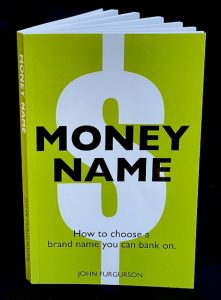
Naming Mistake #1: Falling in love with your own ideas.
It’s relatively easy to come up with a hundred “good” ideas — in your head. But making one of those ideas work in the marketplace is a much different matter.
I’ve seen plenty of business owners who got attached to an idea early on and couldn’t let go.
For instance, I knew an enterprising young coffee roaster who wanted to open a chain of coffee shops. Like most entrepreneurs, he was quite confident that he could compete with Starbucks, Seattle’s Best and Dutch Bros. Then he revealed his brilliant idea for a brand name: Thank The Goat.
“Hmmmmmm,” I said politely.
He proceeded to tell me the riveting story of the Ethiopian goat herder who discovered coffee sometime during the ninth century. The man noticed that his goats were quite energized after eating the fruit of a certain plant, and the rest is history.
So Thank The Goat it is! He was so enamored with that origin story he wasn’t open to any other approaches.
I tried my best to talk him out of it.
I suggested variations of Thank The Goat. I even offered a bunch of alternative names that could work with a goat as the logo. He’d have nothing of it. Needless to say, Thank The Goat Coffee Company did not give Starbucks a run for its money.
There’s an ancient saying akin to: “We don’t see things as they are, we see things as we are.”
Your skewed perspective and preconceived notions alter the way you perceive the world, the market, the product, the business and any potential names. You may think Thank The Goat is the best name since Uber, but you’d be wrong.
It’s important to remain neutral when you’re working on names. If you get emotionally attached to one idea you’ll rush the process and miss many other good possibilities. And when it comes time to check for ® Trademark protection you might be sorely disappointed.
How to come up with a good business name – Mistake #2: Little or no love of words.
Naming is an exercise in semantic invention. That means you have to make up words or combine words in creative new ways.
So it takes a wide range of skills and experience in disciplines that have nothing to do with business. Like art, language, literature, poetry, writing, typography and design.
And what’s more, you also need to have a good sense for business strategy. It takes an ambidextrous brain to come up with good business or product names. You need to dance across disciplines and perform as part word nerd, part MBA grad.
There aren’t too many entrepreneurs who would consider themselves well-schooled in “soft” disciplines like poetry. Hell, I seldom run into a business owner who would even admit to liking literature back in high school or college.
No one goes on Shark Tank and says, “I’m an English lit major and I’m offering 10 percent of my company for $700,000.”
Most business owners are more analytically inclined. They probably spend way more time with numbers and spreadsheets than with words. But it’s words that capture your big idea and send your business rocketing to the moon.
Back in the 1970s, George Lois, an Advertising Hall of Fame art director, came up with the name Lean Cuisine for a new line of low-calorie frozen entrees. Those two words said everything that needed to be said.
Lean Cuisine became a massive success for Stouffer’s and an iconic brand in the frozen food business.
I love Lois’ perspective on words from his book, What’s The Big Idea, “A strong theme compresses everything into one knockout punch. Themes are constructed from words. Too many advertising people think the visual image is our common language. Not so. I’m a designer, and to me our common language is always words.”
Naming is a word game. So if you don’t have an interest in words, find someone who does to help you.
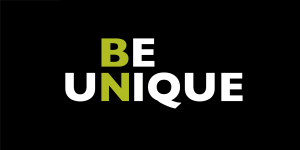
How to come up with a good business name – Mistake #3: A manager’s need for consensus.
When you’re choosing a name for your company, consensus is the last thing you should be concerned about. Just the opposite. You should embrace polarization!
Hot and cold responses are what you’re going for. If the stakeholders are sharply divided — that’s a good sign.
What do you suppose happened when I proposed the name Smidge for a company that makes vitamins, minerals and probiotic supplements? Half the client’s team hated the idea, but the other half loved it. There was no in between, so we knew we had a hit.
On the other hand, if everyone agrees a name is “pretty good,” or worse yet, “fine,” that’s a sure sign it’s a boring, forgettable name. Better throw it out and go back to the drawing board.
Seriously, this is where the vast majority of business owners go wrong. They have a name that seems okay and everyone’s nodding their heads in agreement, so they take that as a green light.
But human nature is working against them. We have a hard-wired preference for things that are familiar. It makes us feel safe and it’s ingrained in the deepest recesses of the brain. So all that head-nodding consensus does not mean it’s a good idea. It just means the name is familiar and safe.
On top of that, we all have phobias to some degree. Specifically, neophobia, the fear of anything too new. So when people hear a name that is truly unique, most will say they don’t like it.
It’s easy to get consensus for names that seem comfortably familiar. But here’s the rub: The more familiar it seems, the less distinctive it is. The last thing you want is a name that is familiar and safe, so you have to deal firmly and directly with the naysayers.
This is a major paradigm shift for most managers who are accustomed to feel-good team building and consensus-based decision making. Normally they work hard to keep the peace. They don’t like dealing with so much divisiveness, so when faced with a name like Smidge most managers would cave in immediately to the naysayers just to avoid conflict.
This is where true leadership comes in to play.
You have to be able to make a decisive, executive decision while still making your team feel like they’ve been heard:
“I appreciate your feedback, and I value your opinion on this. It sounds like everyone’s just lukewarm on this particular name, so we’re going with this other one instead.” (The one that was hated by half the team.)
The objective grading system that I’ll cover later in this book will help tremendously in this type of scenario.
Like Hopkins said, a name should be an advertisement in and of itself. Smidge does everything a good name ought to do; it sounds intriguing, inspires creative advertising ideas, pops out on a store shelf, it accurately reflects the small-dose product, and it makes people smile. At least some people.

Naming Mistake #4: Shortcutting the process.
Naming is a step-by-step process. It takes time, and it goes like this:
Step 1: Brand Strategy — Getting your story straight.
Step 2: Brainstorming — Generating rough ideas.
Step 3: Noodling & Wordsmithing — Crafting the words and narrowing the list.
Step 4: Objective decision making — Grading the finalists.
Step 5: Trademark due diligence — Protecting yourself.
The problem is, when you’re starting a company you need a name early in the process, so it’s not unusual to pick one before there’s a clear brand strategy mapped out. Even with an agency’s help many founders gloss right over this critical first step.
That’s a mistake. As Seth Godin says, “If you don’t have time to do it right, what makes you think you have time to do it over?”
The fact is, the brand framework needs to be spelled out very clearly before you start. Otherwise, the naming process is going to be exponentially harder. You’ll waste way too much time going down bottomless rabbit holes that lead to names that simply aren’t aligned with your values, your market and your operation.
Most of the epic fails in naming history were caused by owners rushing through the work. People jump into the creative process and never take time to do the necessary strategy work on the front end, or the legal due diligence on back end.
I don’t think Prince thought it through very carefully when he rebranded himself in 1993 and became “The Artist Formerly Known As Prince.”
He was angry because Warner Brothers beat his manager to the punch and trademarked the word “Prince,” which was his real first name. He said he felt like a slave to his record label, and he wanted out. Unfortunately, his rebranding effort using an unintelligible symbol for a name, was not the answer.
Here’s another example. Some years ago I had an e-commerce client who came to BN Branding looking for rebranding and packaging design. They had five product lines all under a different brand name, and they said, “here’s our new name, we’d like you to work with this.”
Thankfully — amazingly — the name wasn’t horrible. “Okay,” I said. “We can work with that. But have you guys trademarked this through an attorney?”
“Oh yes, absolutely. We’re good to go,” they assured me. So we went through the entire rebranding process. We built a story around their new brand name. We designed a brand identity to go with that name. We even designed packaging.
Six months later I got a call from the CEO. He was embarrassed and apologetic because, as it turns out, they did not actually have the ® Trademark assigned to their new name. And according to their new law firm, they were never going to get it. It was a costly error that set the company back a full year.
If anyone promises you’ll have naming results in 48 hours, run for the hills.
That’s utter nonsense. You cannot name a company successfully in two days. If you did nothing but naming for two solid weeks you might have a chance of getting something to submit to the United States Patent and Trademark Office (USPTO) for approval.
Be patient throughout the entire process; it really is a virtue when you’re making a big decision on a brand name. Schedule two months for the name generation process, and several more to get the official word from the USPTO on the ® Trademark rights.
One little trick I learned long ago is to put your ideas away in a drawer. If you think you’ve really “got it,” walk away from the project for a day or two, then come back and revisit the idea with a fresh perspective.
Sometimes you give yourself a pat on the back. Other times you wonder what the hell you were thinking.
Sure, you can always do a complete rebranding exercise a couple of years down the road like Jeff Bezos did with his original company, Cadabra. (Sounds like cadaver.) But wouldn’t it be better to just get it right the first time?
All it takes is a little bit of patience, some creativity, a lot of hard work and the ability to follow the directions in this book.
How to come up with a good business name – Naming mistake #5: Where am I?
You know the old saying about retail: “It’s location, location, location!” Well, that does NOT apply to naming.
The location of your business is the most common default solution to the naming problem. It’s the “tell ’em where we’re at” school of business naming — just borrow a geographic location and tack on what you do.
In my hometown there are three names that are applied again and again in virtually every product and service category: “Central Oregon,” “Mountain View,” and “High Desert.” So you see commercials from High Desert Heating and Cooling, Mountain View Heating and Cooling and Central Oregon Heating and Cooling. There’s no way to tell them apart.
In San Francisco it’s “Golden Gate” this or “Bay Area” that. Over and over again. In Seattle, “Puget Sound” is the preferred geographic header. Puget Sound Puppies. Puget Sound Paper. Puget Sound Pugilists.
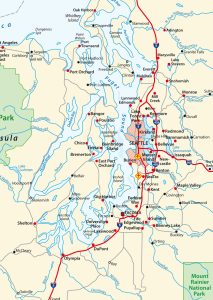
Puget is a horrible sounding word! Just because you’re near that body of water doesn’t mean you should use it as a brand name.
And what happens if your business grows, and you want to expand to Eastern Washington or Portland? You’re stuck with Puget. Pee-u!
Unless there’s virtually zero local competition in your business category – yeah, dream on – a geographic name is a bad idea. If you go that route, you’ll just be lumped into a big bucket of invisible companies with the same brand name, but different category descriptors.
That’s so generic it’s meaningless. Your customers know where they live. They don’t need you to remind them.
Think about it — when someone from San Francisco googles “locksmiths near me” they know they won’t see locksmiths in Vegas or Denver. Google’s search results fit the geographic criteria, by default. So why call it Golden Gate Locksmiths?
Thankfully, the old-fashioned “where am I” approach to naming is far less common today than it was 30 years ago. But even now, plenty of companies are launched with dumb, location-oriented names. And you know what’s even more baffling? Some don’t even get the geography right.
In Minneapolis, Minnesota there are dozens of companies named “Alpine” and “Summit,” yet it’s flat as a pancake up there. It’s thousands of miles from any mountains. Conversely, there’s Coastal Farm & Garden located nowhere near the coast.
If you insist on a geographical name, at least figure out which way’s up, and make it literally correct.
How to come up with a bad business name — #6: “Let’s just name it after me.”
Another common default solution is using your own surname as your brand. If your name is common and forgettable, like, Smith, Jones or Johnson, forget about it!
Or if it’s long and cumbersome like mine… Fur-gur-son would not get good grades on any of my criteria for good brand names.

However, there are times when the last name of the owner can work. If you’re a soloist running a coaching practice or some other professional service, your last name might be okay. As long as your name is short, easy to pronounce, and just different enough.
If you’re Tom Brady and you’re starting a summer camp for young quarterbacks, the naming decision would be a foregone conclusion. The last name itself has relevance, credibility, and intrinsic value in the marketplace. Not only that, Brady sounds good. It’s short and sweet, like Dior or Dyson.
Last names are problematic when there are multiple partners in a new company. If you take Brady and put it together with something like Weinshenkerlip it no longer works.
In rare cases two names can be connected into one memorable name. But the two names put together shouldn’t add up to more than four syllables. And more than two names put together never works. People will just shorten the brand name in their heads to one word, an acronym or even worse, a nickname.
Twelve years ago, I had a client in the property management business. Her last name was Morris and her partner’s name was Hayden. When we put Morris and Hayden together the two last names fit every criterion; it sounds nice, it looks good in type, and it has positive connotations in the category.
Both of those names are highly recognizable and trusted in their local real estate industry. Literally days after they hung up their sign they had people calling, saying, “yeah, I’ve heard of you guys.” It wasn’t true, but the name familiarity worked to their advantage.
Those cases are rare. What’s much more common are the law firms with 13 partners on the letterhead. You don’t want to start sounding like The Law Firm of Ginerra Zifferberg Fritche Whitten Landborg Smith-Locke Stiffleman.
When every partner has their name on the door it’s virtually impossible for the human brain to recall the brand. People will just use the name of the one lawyer they know. Plus, it’s just not practical in everyday use; can you imagine answering the phone at that place? “Hello, GZFWLSLS. How can I help you.”
On the other hand, Michael Dell, with that lovely, four-letter last name that rhymes with well, built an empire off his own name. So I’m not going to tell you it’s impossible; it’s just not likely.
Look at some examples of successful companies named after real people, and think about what they all have in common. They’re short, easy to pronounce, look good in type, sound nice and some even have symbolic resonance: Clif Bar. Ryanair. Boeing. Armani. Ducati.
See what I mean? It doesn’t take a rocket scientist to figure out that the last name Grossenweiner wouldn’t play as well.
Let’s assume for a minute that you’ve ruled out your own last name as the brand name, as well as the name of your location. What else could possibly go wrong?
Naming Trap #7: The generic adjective trap.
This is so painfully obvious I’m reluctant to even mention it. But in every city there are hundreds of companies with names that start with lame-brained adjectives like “Premier” “Superior” and “Quality.”
Chances are, Quality Cleaners and Premier Printing are scraping for a small share of the middle of a me-too market. And Superior Bookkeeping is probably superior to absolutely nothing. It’s just B.S.
Don’t make up superlatives, and don’t choose a generic adjective that applies to every company in your category.
“Comfort” Inn. “Tasty” Dog Treats. “Snooty Links” Country Club. “Creative Services” Advertising. Talk about redundant!
All hotels are expected to be comfortable. All dry cleaners get your clothes clean and pressed. All dog treats are tasty to dogs. That’s just the cost of doing business. That’s the “table stakes” as they say, so those adjectives do nothing for you. In fact, they position you in a category of companies you probably shouldn’t associate yourself with.
Forgettable, run-of-the-mill names imply forgettable, run-of the-mill service. Old, outdated names like Acme or Advanced imply old, outdated operations.
Adding any sort of adjective is an unsavory recipe for a brand name. It will almost surely put your name squarely in the “generic” or “descriptive” categories according to the USPTO.
So if you’re digging around for adjectives to spruce up a prospective name, it’s not a good name to begin with. Toss it in the discard pile.
If you’re going to use an adjective, you’re going to have to work really hard to come up with one that meets all the other criteria. Good luck with that.
Twenty-five years ago Harry Beckwith wrote a series of great little marketing books, starting with Selling the Invisible: A Field Guide to Modern Marketing. He wrote, “descriptive names work logically, but they fail emotionally; they evoke no feelings. Great names like Yahoo! evoke feelings.”
Adjectives are Money Name killers. In journalism school they taught us to delete all adjectives because the whole point of journalism is to stay impartial and emotionless. Just the facts. Any adjectives were circled in red, labeled as “FLUFF” and graded harshly.
Many great brands have learned this lesson and deleted the adjectives from their brand names. Blue Ribbon Sports became Nike. Auction Web became eBay. Pete’s Super Submarines became Subway. Unadulterated Food Products Inc became Snapple. Jerry and David’s Guide to the World Wide Web became Yahoo!.
First they did away with the adjectives. Then they became iconic brands. Iconic brands do not need adjectives.
Naming Trap #8: The dotcom trap
Some people seem to think the best way to start a naming project is with a URL search. That’s how everyone did it during the dotcom boom of the 90s. Just get the .com version of anything, and you’re off to the races. Pets.com was probably the most famous failure, with their multi-million-dollar sock puppet ad campaign.
That approach no longer applies. These days, there are plenty of top-level domain extension options that make the .com URL much less important than it was 25 years ago. You can now choose from a long list of domain extensions, including .biz .net .me .gallery .design .hair .club .spa .travel. And they’re adding new ones all the time. You can build a perfectly credible brand without having a dotcom URL.
Obviously, it’s important to have a URL that dovetails nicely with your brand name, but it doesn’t have to be exact. When we named Smidge, we had to use the URL getsmidge.com. Not as good as Smidge.com, but not a problem.
If you’re concerned about Search Engine Optimization (SEO), just remember this: What Google looks for in a URL is generic and descriptive — the polar opposite of what the USPTO looks for when handing out ® Trademarks. So don’t base your entire naming decision on URL availability.
Find your Money Name. Get it registered with the Trademark office. Then figure out a good URL to go with it.
However, be very careful if you’re adding words to your brand name. URLs are all lowercase, and if you use two words, they sometimes run together in unfortunate ways. For instance, Therapist Finder doesn’t look so appealing when it’s therapistfinder.com. Need some good art fast? Go to speedofart.com. Looking for a nice pen? Buy from Pen Island at penisland.com. See what I mean?
Naming Trap #9: The ABCs and XYZs of alphabet soup.

Here’s another amusing yet unfortunate approach to naming that you can easily avoid.
A lot of people still think they should find a name that begins with the letter A. They believe that’s way better than the letters B, C or D.
Where’d they get that idea? From those annoyingly persistent Yellow Pages salesmen, way back when. They went around telling everyone “You gotta be the first alphabetical listing in your business category.”
Even Jeff Bezos fell for that when he changed his original company name “Cadabra” to Amazon.
That alphabetical “strategy” produced a lot of really crappy names beginning with the letter A. Remember the brand Acme, like in the Road Runner cartoons? Wiley E. Coyote always chose Acme traps and Acme dynamite, even after they kept backfiring on him. I’m glad that’s no longer relevant. This is the 2020s, not 1970s.
Now the pendulum is swinging in the other direction.
People are using a lot of Qs, Xs and Zs for no good reason. (Maybe the success of Zappos contributed to this trend.) You can actually pay $100 a month to “lease” the name Zykiqx until you go out of business. That covers all the unpronounceable letters that appear late in the alphabet.
Zikes!
Pronunciation is a critical factor in naming. If everyone’s wondering how you pronounce Xovux or Xonqo or Xumios, you’re going to be in Xerious trouble.
I was recently working on a naming project for a new law firm. While doing some research I ran across a competing company that made every branding mistake possible. You could tell they started their naming effort with a URL search. They chose what most people would call a good, strong URL. It spelled out the firm’s specialty and pinpointed their geographic location. I won’t divulge the actual name, but it was similar to “Southwesterncorporatelawyers.com.”
Then they just used the acronym of that for their brand name — an ugly string of meaningless capital letters. Finally, they attached a piece of random clip art for a logo and threw together a cheap website that talks about how savvy and professional they are. Worth every penny at $650/hr!
That type of branding communicates a disturbing disconnection. The firm partners don’t see it, but prospective clients surely will.
The point is, if you avoid the most common branding traps and get a few things right from the very beginning, you’ll have a significant competitive advantage over companies that take every shortcut possible.
Need help with your naming? Contact me here, or reach out on LinkedIn! You can buy my book on Amazon, or download the ebook version here.


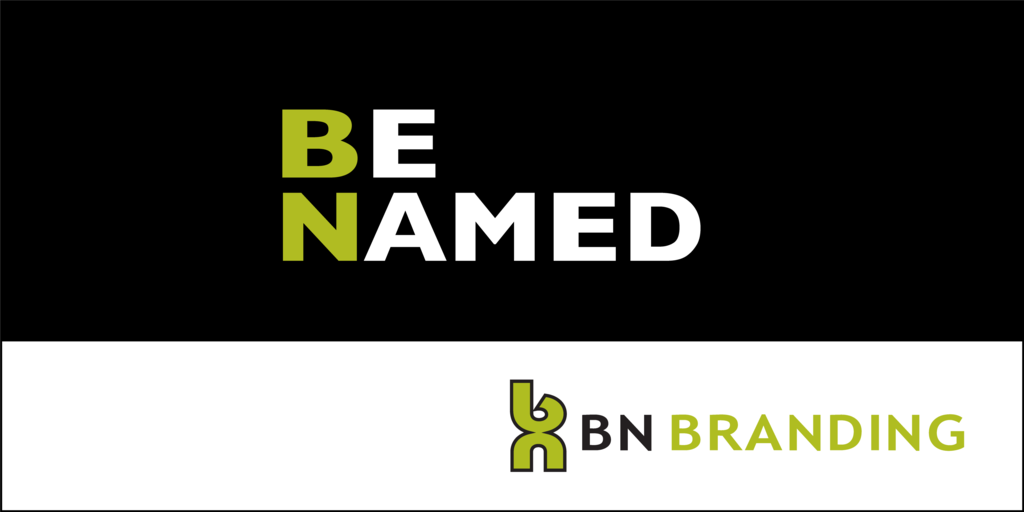
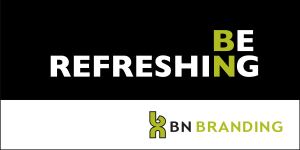
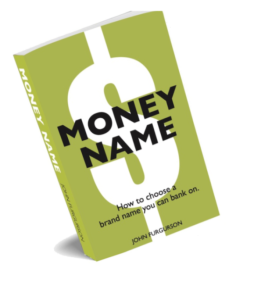
Nice article! Thank you for this article with us.
brand advertising agency
Best Branding Companies in Hyderabad